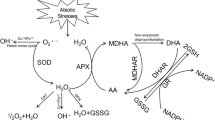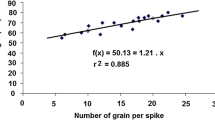Summary
Crop improvement for tolerance to specific herbicides is an important breeding target, since molecules performing well with regard to environmental safety are frequently not completely selective for crops. The glutathione (GSH)/glutathione-S-transferase (GST) system is a general mechanism of detoxification that in higher plants may confer tolerance to some herbicides. GSH level and GST activity were measured in different maize inbred lines, in the absence or in the presence of EPTC (a thiocarbamate) and of Alachlor (a chloroacetanilide); a wide genetic variability was observed for these parameters, which appear to be involved in plant tolerance to herbicides. Isozyme analysis was performed on roots, leaves, scutellum, pollen, coleoptile, mesocotyl of the same inbreds: it revealed the presence of many GST forms in maize, showing high polymorphism; they are controlled by at least five genes, the expression of which is developmentally regulated in the different tissues analyzed.
Similar content being viewed by others

References
DeanJ.V., J.W.Gronwald & M.P.Anderson, 1991. Glutathione S-transferase activity in non-treated and CGA-154281-treated maize shoots. Z. Naturforsch. 46c: 850–855.
EklerZ. & G.R.Stephenson, 1991. Comparative effectiveness and mode of action of safeners for chloroacetamide herbicides in maize seedlings. Z. Naturforsch. 46c: 828–835.
EsterbauerH. & D.Grill, 1978. Seasonal variation of glutathione and glutathione reductase in needles of Picea abies. Plant Physiol. 61: 119–121.
EzraG. & G.R.Stephenson, 1985. Comparative metabolism of atrazine and EPTC in proso millet (Panicum miliaceum L.) and corn. Pestic Biochem. Physiol. 24: 207–212.
Goss, J.R. & B.J. Mazur, 1989. A kaleidoscopic view of crop herbicide resistance. 42nd Meeting Western Soc Weed Sci, Honolulu, Hawaii, pp. 1–22.
GresselJ., 1985. Biotechnologically conferring herbicide resistance in crops: the present realities: In: L.vanVloten-Doting, G.S.P.Groot & T.C.Hall (Eds.). Molecular form and function of the plant genome, Plenum, New York, London, pp. 489–504.
HatziosK.K., 1987. Biotechnology applications in weed management: now and in future. Adv. Agron. 41: 325–375.
HatziosK.K. 1991. An overview of the mechanisms of action of herbicide safeners. Z. Naturforsch. 46c: 819–827.
KomivesA.V., T.Komives & F.Dudka, 1985. Effect of thiocarbamate herbicides on the activity of glutathione S-transferase in maize. Cereal Res. Comm. 13: 253–257.
LayM. & J.E.Casida, 1976. Dichloroacetamide antidotes enhance thiocarbamate sulfoxide detoxification by elevating corn root glutathione content and glutathione S-transferase activity. Pestic. Biochem. Physiol. 6: 442–456.
MooreR.E., M.S.Davies, K.M.O'Connell, E.I.Harding, R.C. Wiegand & D.C.Tiemeier, 1986. Cloning and expression of a cDNA encoding a maize glutathione-S-transferase in E. coli. Nucleic. Acid Res. 14: 7227–7235.
MozerT.J., C.Tiemeier & E.G.Jaworski, 1983. Purification and characterization of corn glutathione S-transferase. Biochemistry 22: 1068–1072.
Nieto-SoteloJ. & T.D.Ho, 1986. Effect of heat shock on the metabolism of glutathione in maize roots. Plant Physiol. 82: 1031–1035.
O'ConnellK.M., E.J.Breaux & R.T.Fraley, 1988. Different rates of metabolism of two chloroacetanilide herbicides in Pioneer 3320 corn. Plant Physiol. 86: 359–363.
OrtD.R., W.H.Ahrens, B.Martin & E.V.Stoller, 1983. Comparison of photosynthetic performance in triazine-resistant and susceptible biotypes of Amaranthus hybridus. Plant Physiol. 72: 925–930.
RennenbergH., 1982. Glutathione metabolism and possible biological roles in higher plants. Phytochemistry 21: 2771–2781.
RicrochA., M.Mousseau, H.Darmency & J.Pernes, 1987. Comparison of triazine-resistant and susceptible cultivated Setaria italica: growth and photosynthetic capacity. Plant Physiol. Biochem. 25(1): 29–34.
Sari-GorlaM., S.Ferrario, L.Gianfranceschi & M.Villa, 1992. Herbicide tolerance in maize. Genetics and pollen selection. In: E.Ottaviano, D.L.Mulcahy, M.Sari-Gorla & G.Bergamini Mulcahy (Eds.), Angiosperm pollen and Ovules, Basic and Applied aspects, Springer Verlag, New York, pp. 364–369.
SchulzA., F.Wengermayer & H.M.Goodman, 1990. Genetic engineering of herbicide resistance in higher plants. C.R. Plant Sci. 9: 1–15.
ShahD.M., C.M.Hironaka, R.C.Wiegand, E.I.Harding, G.G. Krivi & C.Tiemeier, 1986. Structural analysis of a maize gene coning for glutathione-S-transferase involved in herbicide detoxification. Plant Mol. Biol. 6: 203–211.
TimmermanK.P., 1989. Molecular characterization of corn glutathione S-transferase isozymes involved in herbicide detoxication. Plant Physiol. 77: 465–471.
Author information
Authors and Affiliations
Rights and permissions
About this article
Cite this article
Sari-Gorla, M., Ferrario, S., Rossini, L. et al. Developmental expression of glutathione-S-transferase in maize and its possible connection with herbicide tolerance. Euphytica 67, 221–230 (1993). https://doi.org/10.1007/BF00040624
Received:
Accepted:
Issue Date:
DOI: https://doi.org/10.1007/BF00040624



